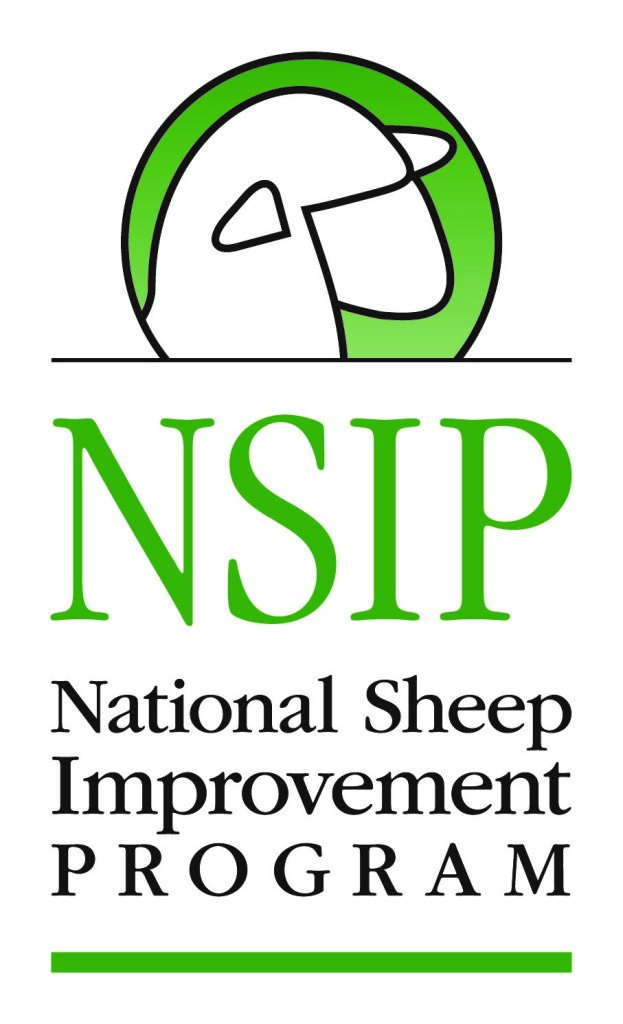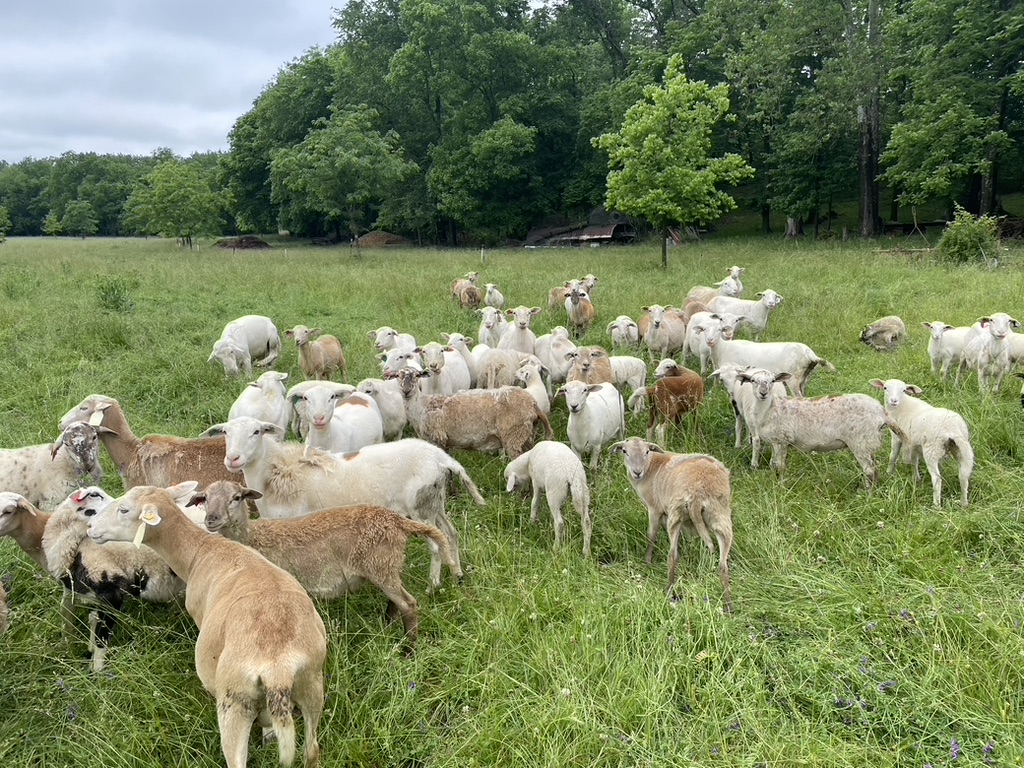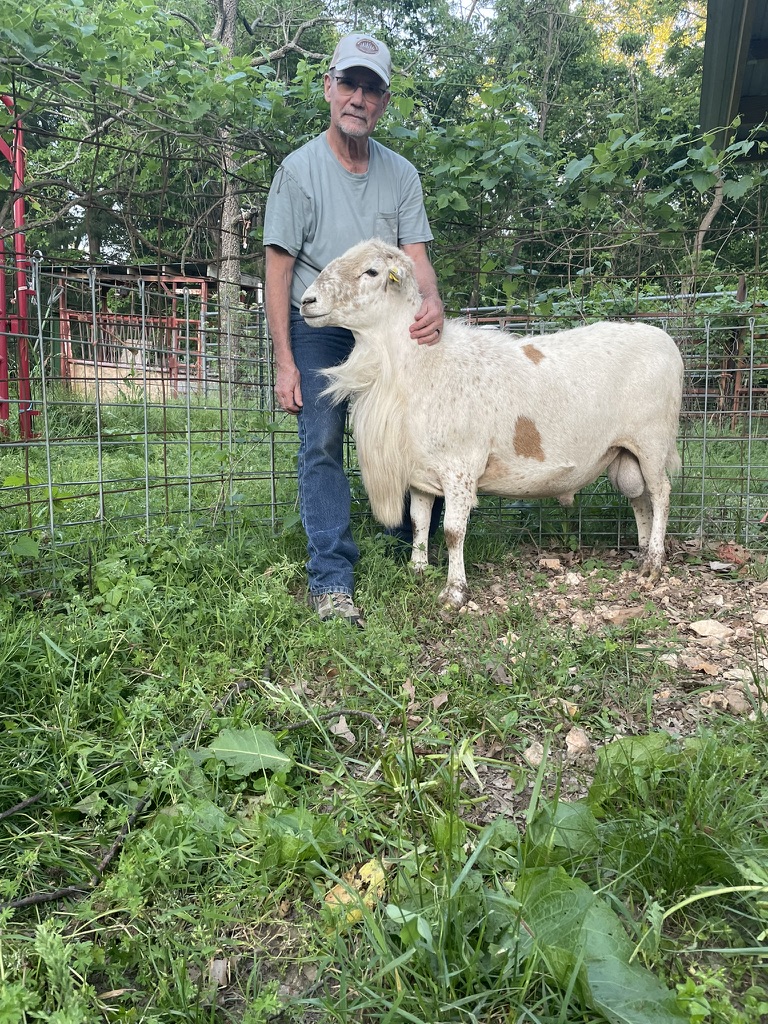Sheep

We have Commercial and Registered Katahdin sheep: We feed no grain to the main flock. We will on occasion feed the lambs creep feed. We lamb on pasture and graze 12 months of the year. We cull heavily, using Tom Lasiter’s criteria only slightly modified for sheep: We cull for disposition; for fertility; for weight of lambs raised; for problems; for needing to be wormed.
In 2018 we started using NSIP.org EBV’s to select rams for worm resistance; as of 2025 no animal on the place has been wormed more than once in the last 4 years, a few animals have never been wormed in their life. We use FAMACHA scores to selectively worm if needed.
We keep about 45 ewes.
Currently we SELECT on weight and worm resistance. Then on milking ability and on the EBV for lambs weaned GREATER than the EBV for lambs born.

Need to learn about sheep ? This quick guide is the best I have seen: https://sheepthings.com/shop/all-sheep/general-books-stickers/quick-reference-guide-for-shepherds/
Since 2018 all rams have been purebred Katahdins or a terminal sire. All are enrolled in NSIP.
Meet our 2025 rams:
“Zimmie” – Yearling ram from Stuart Zimmerman, NISP: 6401822024SRZ069 is high in weaned worm resistance, will be bred to Tom daughters with high post weaning worm resistance. Growth and Milk too!
+1.98 for MWWT (milk/mothering = 99th pct. for US !
+ 5.17Kb (11.4#) for PWWT (post wean wt.) is over 85th pct. in the US.
-82 for WFEC is over 90th pct.
-63 for PFEC is over 70th pct. for worms.
15.4% Lambs weaned > 11.2% born is over 75%.
Picture below:
For 2025:
“Stuie” – NSIP: 6400602021RMK159 is a proven ram we will be using this year. At 270 pounds we are looking for size.
+21.6% for NLW (number of lambs weaned), is over 90th pct. in the US!
+.735 for MWWT (milk and mothering) is about 55th pct. for the US.
+4.05Kg (8.9#) for PWWT (post weaning wt.) is over 70th pct. in the US.
Stuie has decent numbers for worm resistance. Not what we like to see but should be fine bred to our ewes with -70 to -90’s.
More importantly, +21.5% NLW is greater than +20.6% NLB (as you get higher numbers, there will be less spread)
All data can be accessed at NSIP.org
Picture below:
REFERENCE: Tom was used the last 3 years. MINUS 91% for worms puts him at 97th percentile for the whole US ! BUT, all the rest of his numbers dropped to about neutral with moving from Maine and grain fed to SW Missouri brush and fescue pastures. Still positive for post weaned weight of 1.8 pounds. Positive for number of lambs born (6%) but even better is 12% for number of lambs WEANED.
NSIP: 6400052020WVF906
REFERENCE:
Fenton ( 6400312018bcg919 ) was used 2019 to 2023. Strengths -82 WFEC, -92 PFEC, PWWT 4.4Kg.
Fulton ( 6400312019bch987 ) was used 2020 to 2024. Strengths MWWT of 1.5 (over 966h % !!!), -58 WFEC. His PWWT was only 3.7Kg (just over 60th %) but he was a much larger ram.


2025 Ram #3: Picture to come.
Ram lamb from Cody Cave who took over David Copelan’s flock.
NSIP: 6400312025bcr221.
+1.3 for MWWT (milk/mothering = whisker under 90th pct. in the US.
+ 5.9Kg (12.98#) for PWWT is over 95% pct. in the US.
-56 for WFEC is over 75% pct.
-67 for PFEC is just under 80th pct.
19.9% lambs weaned > 18.8% born is over 85% pct. in the US.
–
We love hard data, and NSIP is the best data available, but is NOT the whole picture. We want long productive lives (our oldest ewe is 14 years old and still raising twins) and there is no EBV for that.
Few Thoughts:
The HAIR index is a great single number to select sheep, IF you lamb in jugs/barn and feed grain. The SRC$ Index may be a much better single number for farms that do not feed grain. I think that the BEST approach is to select for 1 or 2 traits that your ewes are weakest in.
I ignore NLB (number of lambs born) as 80-90% of what determines how many lambs are born is NOT GENETICS! Do really like to see lambs that SURVIVE, if so you want NLW>LNB!!!
EBV’s are an ESTIMATE, it will take several generations, ideally with daughters in at least 1 other herd, to get accurate numbers. Look at the lambs sire and dam, and all 4 grandparents, and if they all have about the same EBV for a trait, you can be pretty sure of a decent degree of accuracy.
Read posts at the Eastern Alliance for Production Katahdins that cover each EBV in detail as well as many other topics: https://easternalliancekatahdins.com/
Most hair sheep in the US are Katahdin’s, lots of info at Katahdin Hair Sheep International: https://easternalliancekatahdins.com/
FOR SALE: We only sell animals we would be willing to have in our herd.
We may have a few ewes for sale this fall, waiting on the second set of FEC’s to determine how many ewe lambs we will keep.
We kept one commercial ram lamb (75%) back for sale this fall. We are waiting on Genetic testing report and the results of fecal egg counts (which may change the following numbers – hopefully for the better on FEC’s) before listing for sale, but his current EBV’s:
PWWT (Post Weaning Wt.) of 4.59 Kg (10.1 pounds) puts him over 80th percentile for the US
MWWT (milk/mothering) of 1.241 puts him over the 85th percentile for the US
WFEC (weaning fecal egg counts) of -47.5 puts him over the 60th percentile for the US
PFEC (post weaning fecal egg counts) of -39 still puts him over the 60th percentile for the US
NLW (number of lambs weaned) of 9.7% is significantly greater than number of lambs born (NLB) of 5.1% – remember unless you want a lot of triplets and feed grain you do NOT want super high numbers here! At least 80% of number of lambs born is environment and not genetic.
EBV info fom Gibraltar Farm:
Imagine you are out to buy a new ram, you could select just on how the ram looks and his weight at 120 days (if you were looking for growth). That is a start, but what if you also knew how his weight compared to that of his contemporaries, that will give you a lot better idea of his genetic potential. What will even be better is to also know how well family members grew (offspring, sire and dam, grand sire and grand dam as well siblings and half sibling). It would also be nice to know how well he or his family members performed on other farms that might use different management systems. This level of information is exactly what EBVs provide.
“You buy a ram not for what he looks like but how his progeny will perform” – Sheep Genetics, Australia
We are part of NSIP through which our EBVs are calculated, animal performance is compared against over 4000 lambs and their sires and dams in close to 40 different Katahdin flocks each year. EBVs are expressed as a number above or below an “average” for all animals that participate in the program. The “average” is a baseline calculated at fixed point in time, this allows for better tracking of genetic progress over multiple years. EBVs also have accuracies that are based on the amount of information utilized to calculate the EBV. The percentile report helps you see how an EBV value compares against other animals (latest lamb crop) in the program for each trait measured, 100 th band (percentile) is the top (largest or smallest depending on the trait) performing while the 0 th band (percentile) is the bottom performing. The February 2020 percentile report for Katahdin sheep can be found (on the NSIP.org website)
Some EBVs are correlated with other EBVs, this allows estimates to be created (at a lower accuracy level) even before an EBV can be measured such as estimating WWT once BWT is known (because BWT and WWT are correlated). EBVs can also measure maternal traits in rams, this gives an indication of how ewes produced by the ram will perform (maternal genetics come from the ram and the ewe).